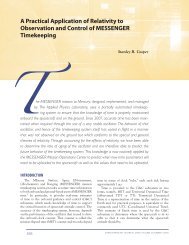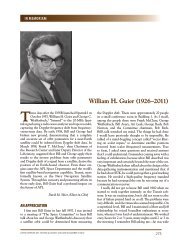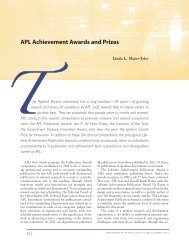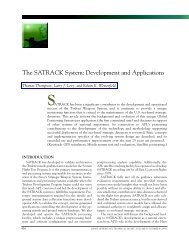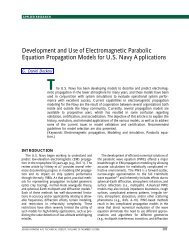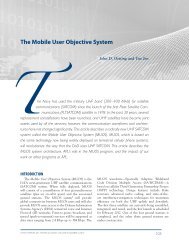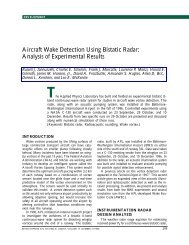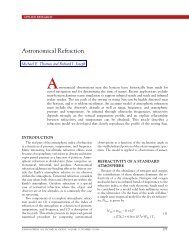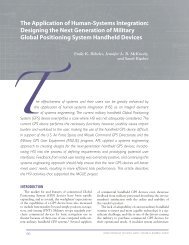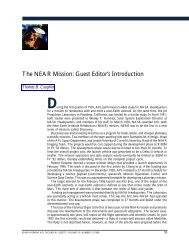Operational Evaluation for Evolutionary Sonars - Johns Hopkins ...
Operational Evaluation for Evolutionary Sonars - Johns Hopkins ...
Operational Evaluation for Evolutionary Sonars - Johns Hopkins ...
You also want an ePaper? Increase the reach of your titles
YUMPU automatically turns print PDFs into web optimized ePapers that Google loves.
B. O. BATES, R. CALHOUN, AND D. E. GRANT<br />
These agencies were tasked to evaluate the operational<br />
effectiveness and suitability of the systems being developed<br />
<strong>for</strong> use by operational <strong>for</strong>ces in harm’s way.<br />
For many years, operational testing followed the lead<br />
of those early testing pioneers and focused on evaluating<br />
the per<strong>for</strong>mance of an end product once it was<br />
turned over by the developer. As one would imagine,<br />
this arrangement led to animosity between the developer<br />
and tester, created schedule and fi nancial problems<br />
when tests went poorly, provided operational feedback<br />
to the developer only after it was much too late to<br />
economically implement lessons learned, and heavily<br />
tasked operational <strong>for</strong>ces to provide manpower and test<br />
assets to support the “graduation exercise.”<br />
By 1996, a new challenge to sonar system operational<br />
testing had emerged. Ef<strong>for</strong>ts to regain and then maintain<br />
submarine acoustic superiority resulted in the development<br />
of an acquisition program known as Acoustic Rapid<br />
Commercial Off-the-Shelf (COTS) Insertion (ARCI).<br />
Under this initiative, technology insertions would be<br />
made to submarine sonar systems on a rapid, periodic<br />
basis (every 1 to 2 years) to ensure hardware currency,<br />
software capability would be updated rapidly (through an<br />
initiative known as the Advanced Processor Build [APB]<br />
program), logistics costs would be effectively contained,<br />
and almost immediate per<strong>for</strong>mance improvements would<br />
be realized. The goal was to complete a four-step process<br />
to fi nal confi guration in about 3 years (as opposed to the<br />
conventional acquisition time lines that exceeded 10<br />
years from inception to completion).<br />
The ARCI program was one of the fi rst large-scale<br />
ef<strong>for</strong>ts designed to take advantage of new acquisition<br />
directives that encouraged execution of evolutionary<br />
acquisition strategies. It was up to the sponsor, developer,<br />
Navy type commanders, and operational test<br />
agency to devise a relationship and strategy that would<br />
meet the needs of all the stakeholders.<br />
<strong>Operational</strong> evaluation assesses the effectiveness and<br />
suitability of a system to support a decision <strong>for</strong> readiness<br />
<strong>for</strong> Fleet introduction. The traditional approach to operational<br />
testing involves a test team that is introduced to<br />
the program shortly be<strong>for</strong>e the test and then observes<br />
the system in operation. Generally, the test team’s<br />
assessment is interpreted as a go/no-go decision and<br />
there is little insight into why a certain per<strong>for</strong>mance is<br />
observed. Limited test time and test assets exacerbate<br />
this shortcoming to operational testing. The observed<br />
per<strong>for</strong>mance <strong>for</strong> the limited test may not represent the<br />
true capability. Currently, the Navy is exploring ways to<br />
improve the test strategy by early involvement in program<br />
development and by including Navy and University<br />
Affi liated Research Center laboratories and systems<br />
developers, in a limited way, in the evaluation team.<br />
This approach helps the evaluation team to develop a<br />
better understanding of program goals, helps the development<br />
team stay current with program needs, ensures<br />
that the test team will retain objectivity, and fosters<br />
trust between the evaluation and development teams.<br />
In this article we address the evolving roles in system<br />
analysis, the advantages of acoustic post-analysis, and<br />
the way beam noise collected during operational test is<br />
used to determine the detection footprint of the sensor<br />
under test.<br />
TESTING PHILOSOPHY<br />
Historically, government test agencies were seen<br />
as organizations that conducted pass/fail testing of a<br />
system’s ability to function effectively and suitably in<br />
an operational environment; the command did not<br />
participate in a program until the engineering development<br />
model was completed and ready <strong>for</strong> technical<br />
evaluation by the government sponsor. However, other<br />
responsibilities were subsequently added that tasked<br />
the testers to become involved in a program early<br />
enough to assess (1) potential operational effectiveness<br />
and suitability of a system and make recommendations<br />
regarding programmatic decisions other than<br />
Fleet introduction, and (2) operational effectiveness<br />
and suitability regarding Fleet introduction decisions.<br />
Given the nature of the evolutionary development<br />
of the build-test-build model used today by both the<br />
submarine and surface combatant communities, government<br />
test team involvement must not only begin<br />
earlier, but must also be continuous in order <strong>for</strong> the<br />
command to contribute meaningful and timely analytical<br />
feedback regarding operational suitability.<br />
A sponsor’s development team comprises personnel<br />
from multiple government agencies and supporting laboratories<br />
who have the required level of technical understanding.<br />
The active duty members of the test team are<br />
drawn from <strong>Operational</strong> Test Directors (OTDs) and<br />
their support staff, who serve on a 2- to 3-year rotation<br />
basis. These active duty participants may lack the <strong>for</strong>mal<br />
education required to understand the complexity of the<br />
complete sonar system undergoing evaluation. However,<br />
they bring military experience that is valuable in providing<br />
a clear picture of current Fleet operations and future<br />
operation needs. Through early involvement in the<br />
process, the government test agency takes advantage of<br />
the other participants’ understanding of the system and<br />
develops relationships with team members. This enables<br />
the command to select timely and credible input sources<br />
<strong>for</strong> reports on operational suitability.<br />
Because an OTD works with multiple programs, he<br />
or she can provide invaluable insight from experiences<br />
with those other programs. The OTD can also give the<br />
program offi ce a unique perspective on how the particular<br />
system could benefi t from achievements or problems<br />
in other systems. This broader perspective helps prevent<br />
connectivity and interoperability issues at an early stage<br />
so that cost-effective corrective action can be taken.<br />
358 JOHNS HOPKINS APL TECHNICAL DIGEST, VOLUME 23, NUMBER 4 (2002)




